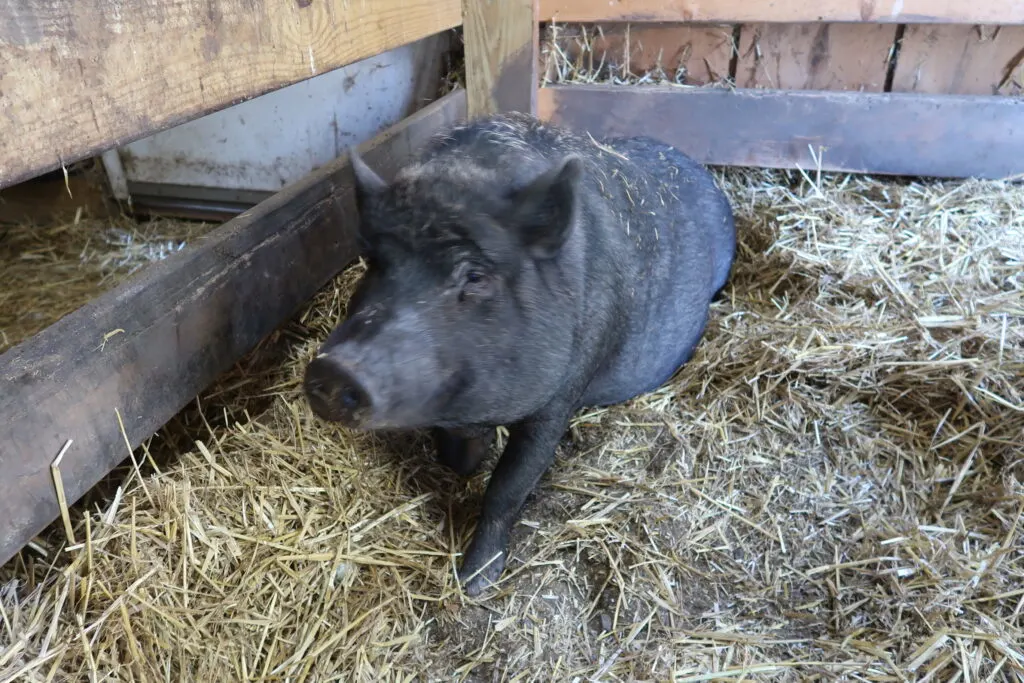As a homesteader with a passion for pigs, I can tell you that finding the right fencing for your pigs can be a daunting task. Pigs are notorious for testing boundaries and breaking through fences.
But don’t worry, after seven years of trial and error, I can confidently say that I’ve found the best fencing for pigs. Keep reading to find out what to consider when selecting fencing, the different types of fencing available, and my personal favorite choice for pig fencing.

Reasons for Pig Fencing
First things first, why even bother with fencing for pigs? Well, there are a few reasons. Pigs need a defined space to feel secure, and fencing helps prevent them from wandering off and getting lost or hurt.
It also keeps predators and other unwanted animals out, like the neighbor’s dog that always seems to find its way onto your property. Additionally, if you plan to breed your pigs, they’ll need their own pen to avoid cross-breeding.

What to Consider
When selecting fencing for your pigs, there are a few factors to consider. One is the size of your pigs. Smaller pigs can squeeze through spaces that larger pigs cannot, so you must consider that when building your fence.
Another thing to consider is the terrain and topography of your land. Pigs can be aggressive and determined, so you’ll want fencing that can withstand their attempts to uproot or damage it.
Lastly, consider your budget. Fencing materials can get expensive, so you’ll want to find a solution that fits your budget without sacrificing durability.
Types of Fencing for Pigs

Permanent Fence
A permanent fence is made of wood, concrete, or metal and deeply rooted in the ground. This is a great option if you plan on keeping pigs long-term, but it can be expensive and take some time to set up.
Electric Fence for Pigs
An electric fence is a temporary option that uses mild electric shocks to keep pigs from breaking through. It’s affordable and easy to implement, but it may not be suitable for all environments.
Electric Netting for Pigs
Electric netting is like electric fencing but is a bit more versatile. It’s portable, can be set up quickly, and can be moved around as needed. This is a good option if you need to change your pigs’ grazing area’s layout frequently.

Pallet Fence
My favorite, pallet fencing, is durable and free (because people are always getting rid of them!). Pallets may not be as pretty as some of the other fencing options, but they’re easy to put up and they hold up against all sorts of pig antics. This is why I think pallets are the best fencing for pigs.

I think pallet fencing is the best for pigs if you can get your hands on it. This, again, depends on what you are raising your pigs for and how many.
For us, with our potbelly pigs, we started with just a few pallets, then expanded the number of pigs, which meant we needed to expand their pen too.

Here is how we built our Pallet Pig Fence
- Figure out the size you would like for your pig pen and how many pallets you need. Ours is 7′ x 10 ‘
Frugal Tip: Check Craigslist for Free pallets or other online selling sites. - Stand the Pallets up on end, starting in one corner, and screw them together one pallet at a time until your perimeter is complete.
- Leave the last pallet loose as a door.
- Add two hinges to one end to create a door for your pig pen.
- Add a latch to keep your door closed.
Your pig pen is now complete. It is amazing at how strong the pallets are when secured together. We crossed pallets every other.

Hog Panels
We started replacing the pallet fence ( after six years) with hog panels just last year. Part of this was I liked to see the pigs out of the kitchen window, which was hard to do with the pallet fence.
Another bonus of the pallet fence for us was none of the goat kids could sneak through or the chickens with the pallet fence.

Now the chickens and goat kids can go through those large square holes. So we put up the fencing we used for the goats over the panels.
The options above will depend on how many pigs you have and the purpose of the pigs. Are you having them for a short period of time? Are they pets? And most important, what is your budget?
Related: How to prepare your pigs for winter
Tips on How to Pig-Proof Your Fence
Once your pig fencing is set up, you’ll want to ensure it’s pig-proof. Pigs are crafty creatures, and they’ll do whatever it takes to break through a fence if they see something they want on the other side.
To pig-proof your fence, check it regularly for any weak points or areas needing reinforcement. Pigs will try to lift anything with their snouts; I have found that with the pallet fencing the way you lock them together, it’s pretty much impossible for them to push the pallets up.
When finding the best fencing for your pigs, you may need to try a few options before settling on the perfect fit. Consider the size of your pigs, the topography of your land, and your budget when selecting fencing materials.
Whether you opt for a permanent fence or a more temporary option, pig-proof it to prevent breaks and escapes. And if you’re looking for a durable, budget-friendly option that won’t sacrifice quality, I highly recommend pallet fencing.
